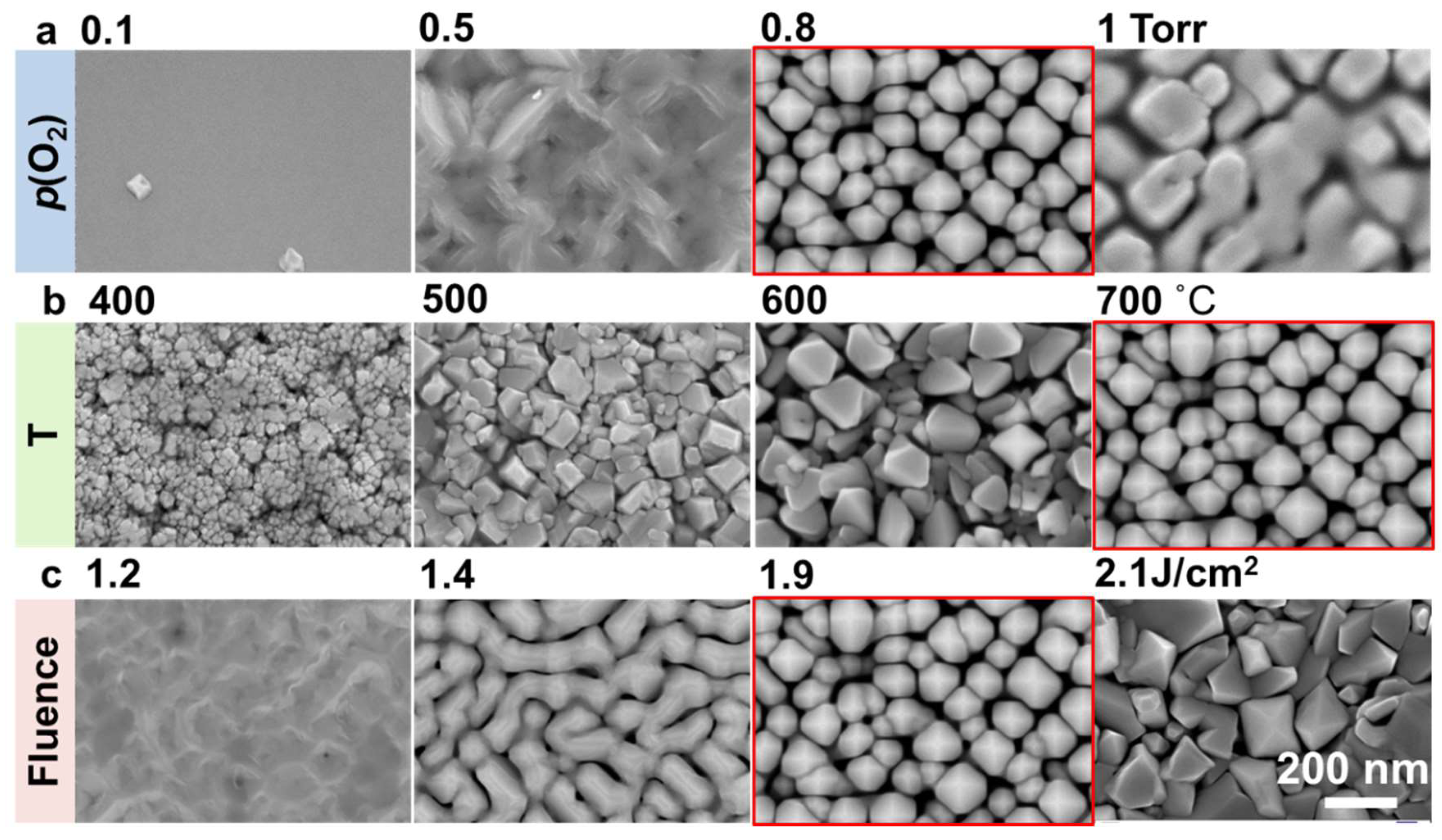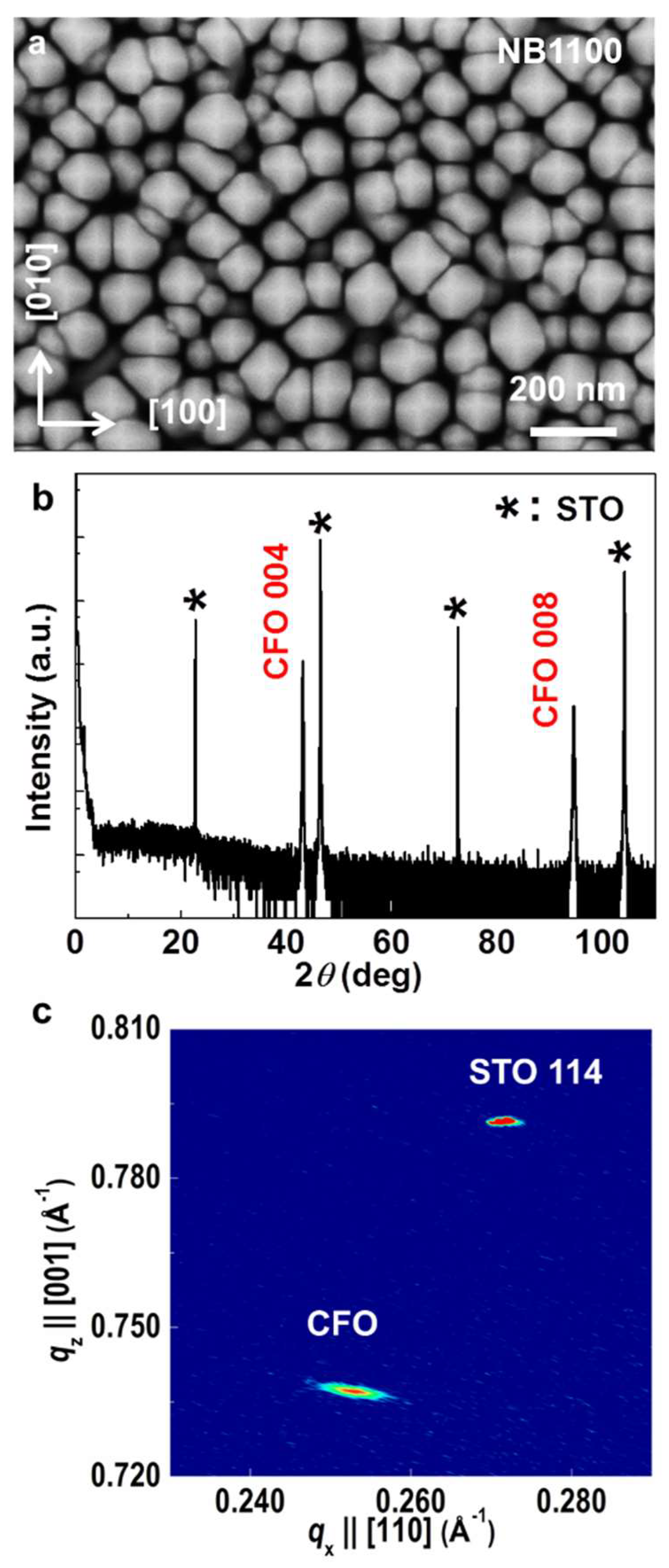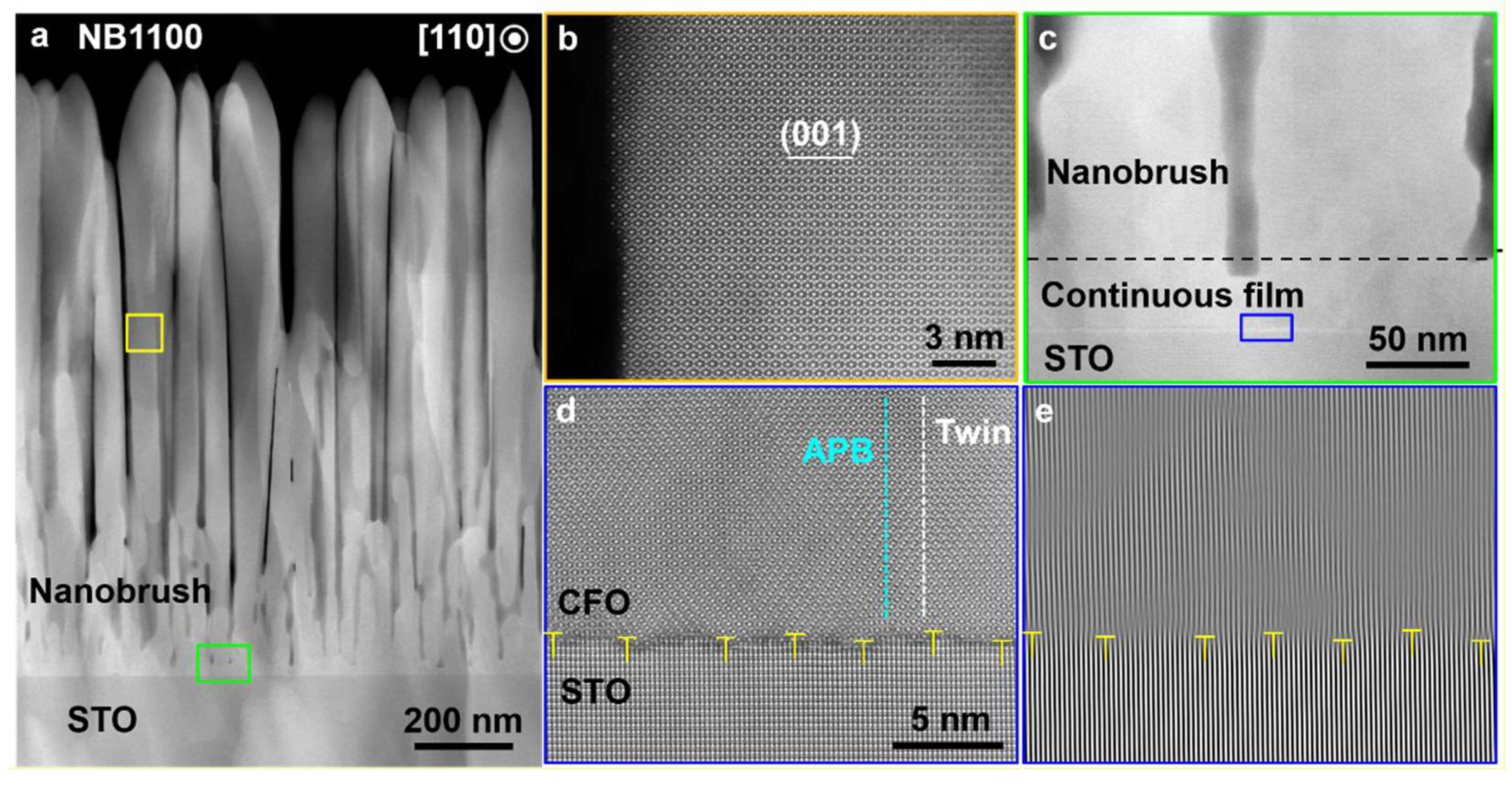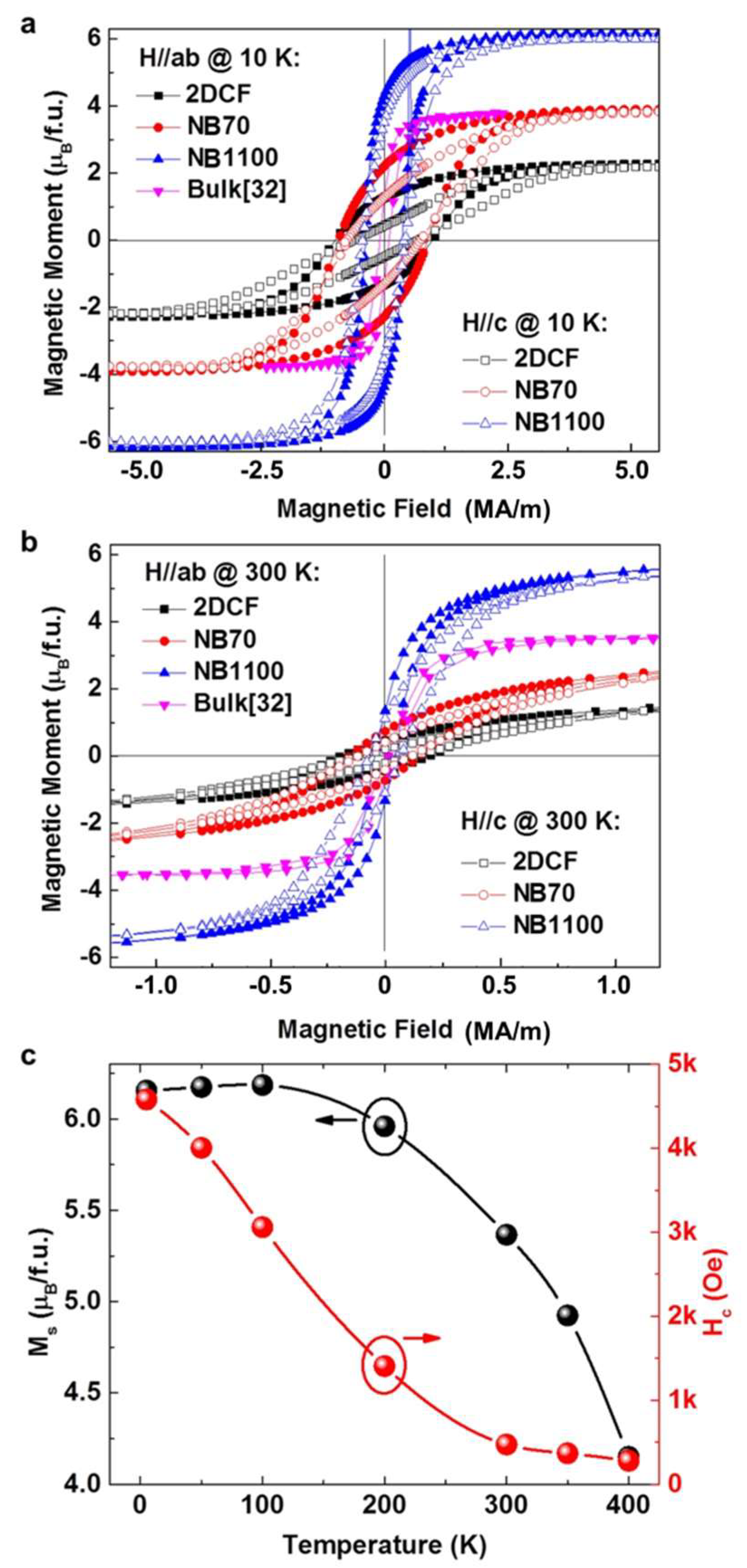Vertically Aligned Single-Crystalline CoFe2O4 Nanobrush Architectures with High Magnetization and Tailored Magnetic Anisotropy
Abstract
1. Introduction
2. Materials and Methods
3. Results
3.1. Self-Assembly of the CoFe2O4 Nanobrushes
3.2. Microstructure of the CoFe2O4 Nanobrushes
3.3. Magnetization of the CoFe2O4 Nanobrushes
4. Discussion
Supplementary Materials
Author Contributions
Funding
Acknowledgments
Conflicts of Interest
References
- Srivastava, A.K. Oxide Nanostructures: Growth, Microstructures and Properties; Chapter 1; Pan Stanford Pte. Ltd.: Boca Raton, FL, USA, 2014; pp. 1–77. [Google Scholar]
- Xia, Y.; Yang, P.; Sun, Y.; Wu, Y.; Mayers, B.; Gates, B.; Yin, Y.; Kim, F.; Yan, H. One-Dimensional Nanostructures: Synthesis, Characterization, and Applications. Adv. Mater. 2003, 15, 353. [Google Scholar] [CrossRef]
- Rorvik, P.M.; Grande, T.; Einarsrud, M.A. One-Dimensional Nanostructures of Ferroelectric Perovskites. Adv. Mater. 2011, 23, 4007. [Google Scholar] [CrossRef] [PubMed]
- Xu, S.; Wang, Z.L. One-dimensional ZnO nanostructures: Solution growth and functional properties. Nano Res. 2011, 4, 1013–1098. [Google Scholar] [CrossRef]
- Infortuna, A.; H arvey, A.S.; Gauckler, L.J. Microstructures of CGO and YSZ Thin Films by Pulsed Laser Deposition. Adv. Funct. Mater. 2008, 18, 127. [Google Scholar] [CrossRef]
- Zhou, Y.; Park, C.S.; Wu, C.H.; Maurya, D.; Murayama, M.; Kumar, A.; Katiyar, R.S.; Priya, S. Microstructure and surface morphology evolution of pulsed laser deposited piezoelectric BaTiO3 films. J. Mater. Chem. C 2013, 1, 6308. [Google Scholar] [CrossRef]
- Jiang, J.; Henry, L.L.; Gnansekar, K.I.; Chen, C.; Meletis, E.I. Self-Assembly of Highly Epitaxial (La,Sr)MnO3 Nanorods on (001) LaAlO3. Nano Lett. 2004, 4, 741. [Google Scholar] [CrossRef]
- Zhang, K.; Dai, J.; Zhu, X.; Zhu, X.; Zou, X.; Zhang, P.; Hu, L.; Lu, W.; Song, W.; Sheng, Z.; et al. Vertical La0.7Ca0.3MnO3 nanorods tailored by high magnetic field assisted pulsed laser deposition. Sci. Rep. 2016, 6, 19483. [Google Scholar] [CrossRef]
- Fan, L.; Gao, X.; Lee, D.K.; Guo, E.J.; Lee, S.B.; Snijders, P.C.; Ward, T.Z.; Chisholm, M.F.; Eres, G.; Lee, H.N. Kinetic controlled fabrication of single-crystalline TiO2 nanobrush architecture. Adv. Sci. 2017, 4, 1700045. [Google Scholar] [CrossRef]
- Lee, D.K.; Gao, X.; Fan, L.; Guo, E.J.; Farmer, T.O.; Heller, W.T.; Ward, T.Z.; Eres, G.; Fitzsimmons, M.R.; Chisholm, M.F.; et al. Non-equilibrium synthesis of highly porous single-crystalline oxide nanostructures. Adv. Mater. Interfaces 2017, 4, 1601034. [Google Scholar] [CrossRef]
- Zheng, H.; Wang, J.; Lofland, S.E.; Ma, Z.; Mahaddes-Ardabili, L.; Zhao, T.; Salamanca-Riba, L.; Shinde, S.R.; Ogale, S.B.; Bai, F.; et al. Multiferroic BaTiO3-CoFe2O4 nanostructures. Science 2004, 303, 661–663. [Google Scholar] [CrossRef]
- Zavaliche, F.; Zheng, H.; Mohaddes-Ardabili, L.; Yang, S.Y.; Zhan, Q.; Shafer, P.; Reilly, E.; Chopdekar, R.; Jia, Y.; Wright, P.; et al. Electric Field-Induced Magnetization Switching in Epitaxial Columnar Nanostructures. Nano Lett. 2005, 5, 1793–1796. [Google Scholar] [CrossRef]
- Chapline, M.G.; Wang, S.X. Room-temperature spin filerting in a CoFe2O4/MgAl2O4/Fe3O4 magnetic tunnel barrier. Phys. Rev. B 2006, 74, 014418. [Google Scholar] [CrossRef]
- Ramos, A.V.; Santos, T.S.; Miao, G.X.; Guittet, M.-J.; Moussy, J.-B.; Moodera, J.S. Influence of oxidation on the spin-filtering properties of CoFe2O4 and the resultant spin polarization. Phys. Rev. B 2008, 78, 180402. [Google Scholar] [CrossRef]
- Fritsch, D.; Ederer, C. Epitaxial strain effects in the spinel ferrites CoFe2O4 and NiFe2O4 from first principles. Phys. Rev. B 2010, 82, 104117. [Google Scholar] [CrossRef]
- Zhou, S.; Potzger, K.; Xu, Q.; Keupper, K.; Talut, G.; Marko, D.; Mucklich, A.; Helm, M.; Fassbender, J.; Arenholz, E.; et al. Spinel ferrite nanocrystals embedded inside ZnO: Magnetic, electronic, and magnetotransport properties. Phys. Rev. B 2009, 80, 094409. [Google Scholar] [CrossRef]
- Lisfi, A.; Williams, C.M. Magnetic anisotropy and domain structure in epitaxial CoFe2O4 thin films. J. Appl. Phys. 2003, 93, 8143–8145. [Google Scholar] [CrossRef]
- Park, J.H.; Lee, J.H.; Kim, M.G.; Jeong, Y.K.; Oak, M.A.; Jang, H.M.; Choi, H.J.; Scott, J.F. In-plane strain control of the magnetic remanence and cation-charge redistribution in CoFe2O4 thin film grown on a piezoelectric substrate. Phys. Rev. B 2010, 81, 134401. [Google Scholar] [CrossRef]
- Ma, J.X.; Mazumdar, D.; Kim, G.; Sato, H.; Bao, N.Z.; Gupta, A. A robust approach for the growth of epitaxial spinel ferrite films. J. Appl. Phys. 2010, 108, 063917. [Google Scholar] [CrossRef]
- Walsh, A.; Wei, S.H.; Yan, Y.; Al-Jassim, M.M.; Turner, J.A. Structural, magnetic, and electronic properties of the Co-Fe-Al oxide spinel system: Density-functional theory calculations. Phys. Rev. B 2007, 76, 165119. [Google Scholar] [CrossRef]
- Szotek, Z.; Temmerman, W.M.; Kodderitzsch, D.; Svane, A.; Petit, L.; Winter, H. Electronic structures of normal and inverse spinel ferrite from first principles. Phys. Rev. B 2006, 74, 174431. [Google Scholar] [CrossRef]
- Hou, Y.H.; Zhao, Y.J.; Liu, Z.W.; Yu, H.Y.; Zhong, X.C.; Qiu, W.Q.; Zeng, D.C.; Wen, L.S. Structural, electronic and magnetic properties of partially inverse spinel CoFe2O4: A first principles study. J. Phys. D Appl. Phys. 2010, 43, 445003. [Google Scholar] [CrossRef]
- Wang, Z.; Viswan, R.; Hu, B.; Harris, V.G.; Li, J.F.; Viehland, D. Tunable magnetic anisotropy of CoFe2O4 nanopillar arrays released from BiFeO3 matrix. Phys. Status Solidi RRL 2012, 6, 92–94. [Google Scholar] [CrossRef]
- Gao, X.; Liu, L.; Birajdar, B.; Ziese, M.; Lee, W.; Alexe, M.; Hesse, D. High-density periodically ordered magnetic cobalt ferrite nanodot arrays by template-assisted pulsed laser deposition. Adv. Funct. Mater. 2009, 19, 3450–3455. [Google Scholar] [CrossRef]
- Guo, E.J.; Herklotz, A.; Kehlberger, A.; Cramer, J.; Jakob, G.; Klaui, M. Thermal generation of spin current in epitaxial CoFe2O4 thin films. Appl. Phys. Lett. 2016, 108, 022403. [Google Scholar] [CrossRef]
- Mathew, D.S.; Juang, R.S. An overview of the structure and magnetism of spinel ferrite. Chem. Eng. J. 2007, 129, 51–65. [Google Scholar] [CrossRef]
- Pelliccione, M.; Lu, T.M. Evolution of Thin Film Morphology; Chapter 9; Springer-Verlag: Berlin/Heidelber, Germany, 2008; pp. 121–136. [Google Scholar]
- Thornton, J.A. High rate thick film growth. Ann. Rev. Mater. 1977, 7, 239–260. [Google Scholar] [CrossRef]
- Muller, K.H. Dependence of thin-film microstructure on deposition rate by means of a computer simulation. J. Appl. Phys. 1985, 58, 2573. [Google Scholar] [CrossRef]
- Yang, Y.G.; Johnson, R.A.; Wadley, H.N.G. A Monte Carlo simulation of the physical vapor deposition of nickel. Acta Mater. 1997, 45, 1455–1468. [Google Scholar] [CrossRef]
- Lu, Y.; Wang, C.; Gao, Y.; Shi, R.; Liu, X.; Wang, Y. Microstructure map for self organized phase separation during film deposition. Phys. Rev. Lett. 2012, 109, 086101. [Google Scholar] [CrossRef]
- Wang, W.H.; Ren, X. Flux growth of high-quality CoFe2O4 single crystals and their characterization. J. Cryst. Growth 2006, 289, 605–608. [Google Scholar] [CrossRef]
- Moussy, J.B.; Gota, S.; Bataille, A.; Guittet, M.J.; Guatier-Soyer, M.; Delille, F.; Dieny, B.; Ott, F.; Doan, T.D.; Warin, P.; et al. Thickness dependence of anomalous magnetic behavior in epitaxial Fe3O4(111) thin films: Effect of density of antiphase boundaries. Phys Rev. B 2004, 70, 174448. [Google Scholar] [CrossRef]
- Sawatzky, G.A.; Van Der Woude, F.; Morrish, A.H. Mossbauer study of several ferromagnetic spinel. Phys. Rev. 1969, 187, 747. [Google Scholar] [CrossRef]
- Murray, P.J.; Linnett, J.W. Mössbauer studies in the spinel system CoxFe3-xO4. J. Phys. Chem. Solids 1976, 37, 619. [Google Scholar] [CrossRef]
- Skomski, R. Simple Models for Magnetism; Oxford university press: Oxford, United Kingdom, 2008. [Google Scholar]
- Herklotz, A.; Gai, Z.; Sharma, Y.; Huon, A.; Rus, S.F.; Sun, L.; Shen, J.; Rack, P.D.; Ward, T.Z. Designing magnetic anisotropy through strain doping. Adv. Sci. 2018, 5, 1800356. [Google Scholar] [CrossRef]
- Bozorth, R.M.; Walker, J.G. Magnetostriction of single crystals of cobalt and nickel ferrites. Phys. Rev. 1952, 88, 1209. [Google Scholar] [CrossRef]
- Aimon, N.M.; Hun Kim, D.; Kyoon Choi, H.; Ross, C.A. Deposition of epitaxial BiFeO3/CoFe2O4 nanocomposites on (001) SrTiO3 by combinatorial pulsed laser deposition. Appl. Phys. Lett. 2012, 100, 092901. [Google Scholar] [CrossRef]
- Callen, E.R.; Callen, H.B. Magnetoelastic Coupling in Cubic Crystal. Phys. Rev. 1963, 129, 578. [Google Scholar] [CrossRef]




| T (K) | Sample | Ms_H//ab (μB/f.u.) | Ms_H//c (μB/f.u.) | Hc_H//ab (MA/m) | Hc_H//c (MA/m) |
|---|---|---|---|---|---|
| 10 | 2DCF | 2.27 | 2.19 | 0.99 | 0.65 |
| NB70 | 3.89 | 3.85 | 0.90 | 0.75 | |
| NB1100 | 6.16 ± 0.71 | 6.00 ± 0.63 | 0.37 | 0.42 | |
| Bulk [32] | 3.65 | - | 0.10 | - | |
| 300 | 2DCF | 1.83 | 1.87 | 0.19 | 0.11 |
| NB70 | 3.13 | 3.17 | 0.15 | 0.10 | |
| NB1100 | 5.90 ± 0.61 | 5.64 ± 0.59 | 0.05 | 0.07 | |
| Bulk [32] | 3.57 | - | 0.02 | - |
© 2020 by the authors. Licensee MDPI, Basel, Switzerland. This article is an open access article distributed under the terms and conditions of the Creative Commons Attribution (CC BY) license (http://creativecommons.org/licenses/by/4.0/).
Share and Cite
Fan, L.; Gao, X.; Farmer, T.O.; Lee, D.; Guo, E.-J.; Mu, S.; Wang, K.; Fitzsimmons, M.R.; Chisholm, M.F.; Ward, T.Z.; et al. Vertically Aligned Single-Crystalline CoFe2O4 Nanobrush Architectures with High Magnetization and Tailored Magnetic Anisotropy. Nanomaterials 2020, 10, 472. https://doi.org/10.3390/nano10030472
Fan L, Gao X, Farmer TO, Lee D, Guo E-J, Mu S, Wang K, Fitzsimmons MR, Chisholm MF, Ward TZ, et al. Vertically Aligned Single-Crystalline CoFe2O4 Nanobrush Architectures with High Magnetization and Tailored Magnetic Anisotropy. Nanomaterials. 2020; 10(3):472. https://doi.org/10.3390/nano10030472
Chicago/Turabian StyleFan, Lisha, Xiang Gao, Thomas O. Farmer, Dongkyu Lee, Er-Jia Guo, Sai Mu, Kai Wang, Michael R. Fitzsimmons, Matthew F. Chisholm, Thomas Z. Ward, and et al. 2020. "Vertically Aligned Single-Crystalline CoFe2O4 Nanobrush Architectures with High Magnetization and Tailored Magnetic Anisotropy" Nanomaterials 10, no. 3: 472. https://doi.org/10.3390/nano10030472
APA StyleFan, L., Gao, X., Farmer, T. O., Lee, D., Guo, E.-J., Mu, S., Wang, K., Fitzsimmons, M. R., Chisholm, M. F., Ward, T. Z., Eres, G., & Lee, H. N. (2020). Vertically Aligned Single-Crystalline CoFe2O4 Nanobrush Architectures with High Magnetization and Tailored Magnetic Anisotropy. Nanomaterials, 10(3), 472. https://doi.org/10.3390/nano10030472







